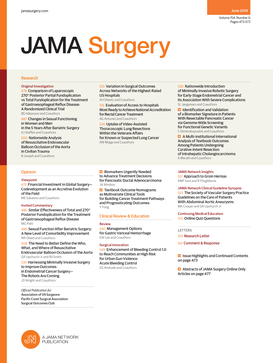前往高流量中心就诊与癌症食管切除术后的存活率
IF 15.7
1区 医学
Q1 SURGERY
引用次数: 0
摘要
重要性目前正在鼓励将食管腺癌的治疗区域化,将其集中到高容量中心(HVC)。目标确定与在当地低流量中心(LVC)接受治疗相比,前往高流量中心接受食管切除术是否与较高的总生存率有关。这项队列研究考虑了 2010-2021 年国家癌症数据库中所有确诊为 I 期至 III 期食管腺癌患者的数据。根据患者接受治疗的旅行距离和治疗医院的年食管切除术量对患者进行分层:旅行-HVC队列包括旅行负担最高的第25个百分位数的患者,他们在治疗量最高的四分位数的中心接受治疗;当地-LVC队列代表旅行负担最低的第25个百分位数的患者,他们在治疗量最低的四分位数的中心接受治疗。主要结果和测量指标主要终点是1年和5年的总生存率。次要终点包括围手术期结果以及与出差接受治疗相关的因素。结果在17 970名患者中,有2342人(13%)属于出差-HVC队列,1969人(11%)属于本地-LVC队列。中位数(IQR)年龄为 65(58-71)岁;3748(87%)人为男性,563(13%)人为女性。经过风险调整后,以当地 LVC 的护理为参照,前往 HVC 与 1 年(死亡率危险比 [HR],0.69;95% CI,0.58-0.83)和 5 年(HR,0.80;95% CI,0.70-0.90)的较高生存率相关。根据分期进行分层,前往 HVC 与 I 期疾病的结果相当,但 III 期疾病的死亡率降低(1 年 HR,0.72;95% CI,0.60-0.87;5 年 HR,0.83;95% CI,0.74-0.93)。此外,前往 HVC 与更多的淋巴结切除(β,5.08 个结节;95% CI,3.78-6.37)和边缘阴性切除的可能性(调整后的几率比为 1.83;95% CI,1.29-2.60)相关。未来的研究需要确定治疗障碍,并开发新的有针对性的途径,以确保患者能公平地获得高容量设施和高质量的肿瘤治疗。本文章由计算机程序翻译,如有差异,请以英文原文为准。
Travel to High-Volume Centers and Survival After Esophagectomy for Cancer
ImportanceOngoing efforts have encouraged the regionalization of esophageal adenocarcinoma treatment to high-volume centers (HVCs). Yet such centralization has been linked with increased patient travel burden and reduced postoperative continuity of care.ObjectiveTo determine whether traveling to undergo esophagectomy at HVCs is linked with superior overall survival compared with receiving care locally at low-volume centers (LVC).Design, Setting, and ParticipantsThis cohort study considered data for all patients diagnosed with stage I through III esophageal adenocarcinoma in the 2010-2021 National Cancer Database. Patients were stratified based on distance traveled to receive care and the annual esophagectomy volume at the treating hospital: the travel-HVC cohort included patients in the top 25th percentile of travel burden who received care at centers in the top volume quartile, and the local-LVC cohort represented those in the bottom 25th percentile of travel burden who were treated at centers in the lowest volume quartile. Data were analyzed from July 2023 to January 2024.Main Outcomes and MeasuresThe primary end points were overall survival at 1 year and 5 years. Secondary end points included perioperative outcomes and factors linked with traveling to receive care.ResultsOf 17 970 patients, 2342 (13%) comprised the travel-HVC cohort, and 1969 (11%), the local-LVC cohort. The median (IQR) age was 65 (58-71) years; 3748 (87%) were male and 563 (13%) were female. After risk adjustment and with care at local LVCs as the reference, traveling to HVC was associated with superior survival at 1 year (hazard ratio for mortality [HR], 0.69; 95% CI, 0.58-0.83) and 5 years (HR, 0.80; 95% CI, 0.70-0.90). Stratifying by stage, traveling to HVCs was associated with comparable outcomes for stage I disease but reduced mortality for stage III (1-year HR, 0.72; 95% CI, 0.60-0.87; 5-year HR, 0.83; 95% CI, 0.74-0.93). Further, traveling to HVC was associated with greater lymph node harvest (β, 5.08 nodes; 95% CI, 3.78-6.37) and likelihood of margin-negative resection (adjusted odds ratio, 1.83; 95% CI, 1.29-2.60).Conclusions and RelevanceTraveling to HVCs for esophagectomy was associated with improved 1-year and 5-year survival compared with receiving care locally at LVCs, particularly among patients with locoregionally advanced disease. Future studies are needed to ascertain barriers to care and develop novel targeted pathways to ensure equitable access to high-volume facilities and high-quality oncologic care.
求助全文
通过发布文献求助,成功后即可免费获取论文全文。
去求助
来源期刊

JAMA surgery
SURGERY-
CiteScore
20.80
自引率
3.60%
发文量
400
期刊介绍:
JAMA Surgery, an international peer-reviewed journal established in 1920, is the official publication of the Association of VA Surgeons, the Pacific Coast Surgical Association, and the Surgical Outcomes Club.It is a proud member of the JAMA Network, a consortium of peer-reviewed general medical and specialty publications.
 求助内容:
求助内容: 应助结果提醒方式:
应助结果提醒方式:


